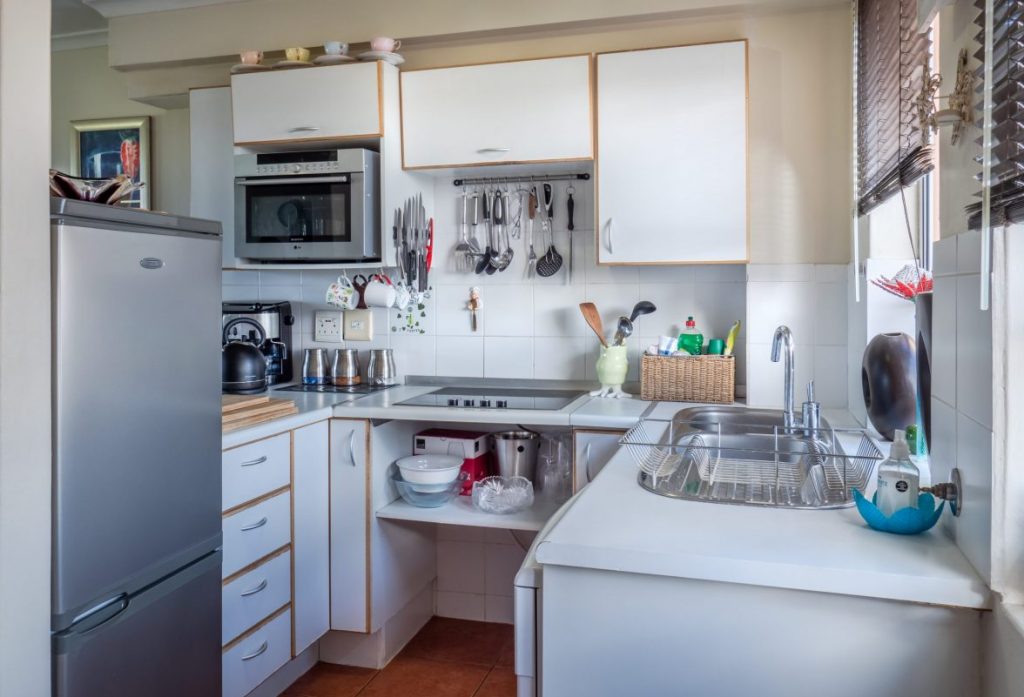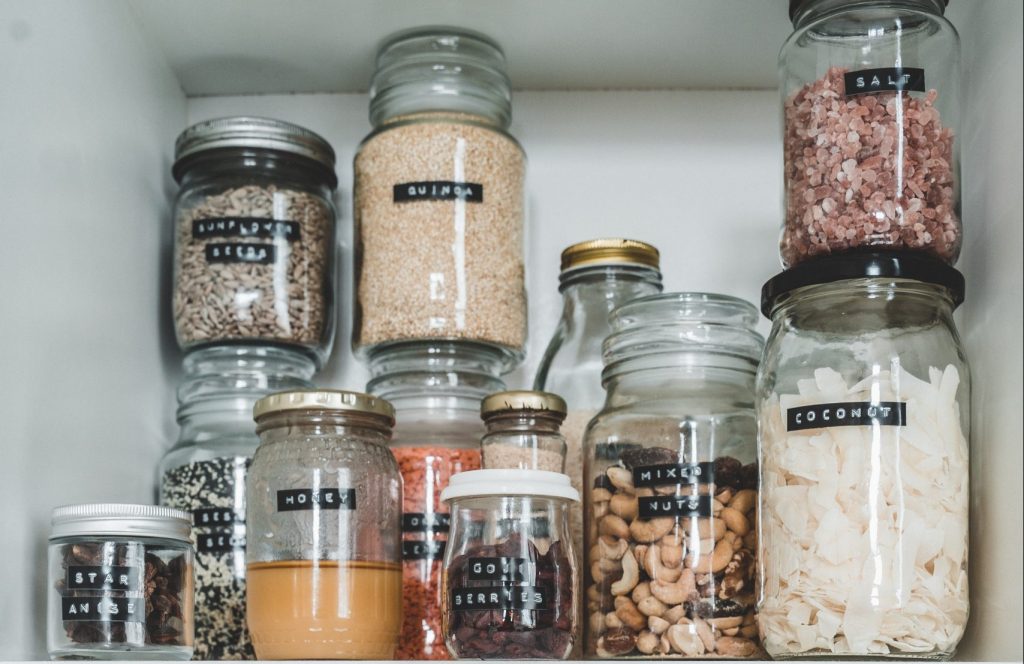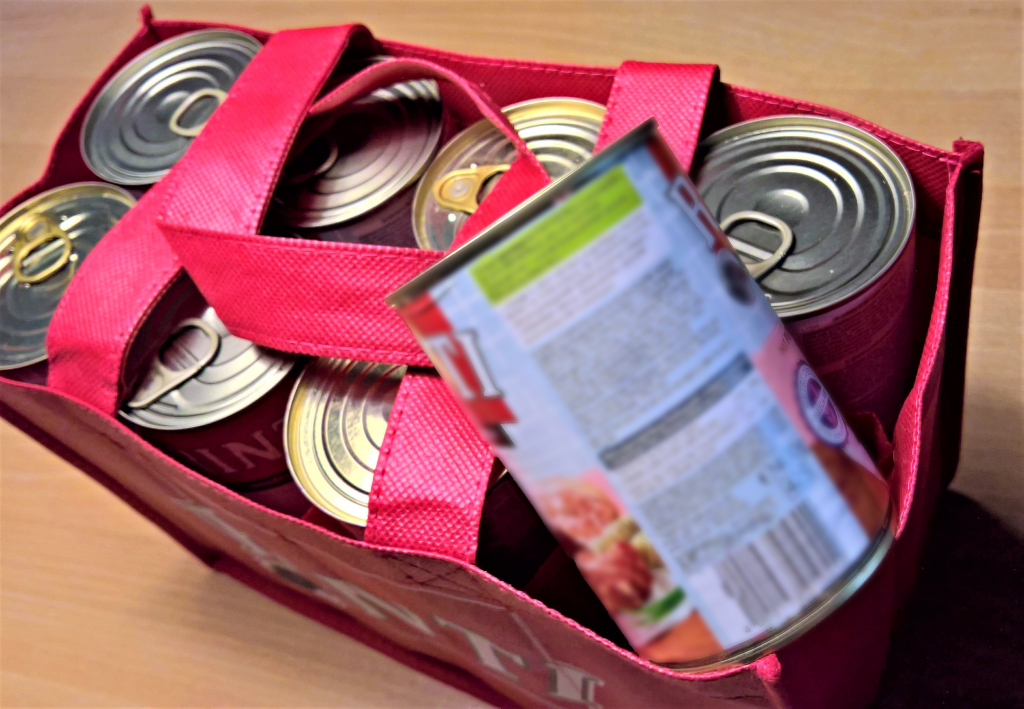In the Kitchen

Making homemade meals is one of the best things you can do for your health and budget. When you cook at home, you control what goes into your food and your portion sizes. You get to decide what seasonings to use and how much, what type of fat to use (if any), and if sugar and salt are actually needed. Cooking from scratch rather than using pre-made foods lets you control the SoFAS in your diet and it is often less expensive than buying boxed mixes and pre-cooked meals.
Making a menu plan, as discussed in the previous section, is key to making it easy to cook on any day of the week, even with a busy schedule. This section will provide you with additional tools and tips to make homemade meals simple.
Basic Kitchen Tools
When it comes to cooking good meals quickly, having the right kitchen equipment makes a difference. This does not mean you need to have expensive pots, pans, and utensils. Rather, having the right size of pots and pans, and utensils that are easy and safe to use is important. Pick cooking utensils that you are comfortable using and that won’t melt or break during cooking.
The following page lists recommended basic kitchen tools that are used in this cookbook. Some of these items you may receive during Cent$ible Nutrition Program classes. Others you may be able to find inexpensively. You don’t need to have everything to start cooking. Instead, build up your kitchen a little at a time, focusing on the equipment you need and use regularly.


- 2-inch or 3-inch paring knife
- 8-inch chef’s knife
- Baking dish (9×13-inch)
- Baking pans (8×8-inch or 9×9-inch)
- Baking sheet (any size)
- Can opener
- Colander/strainer
- Cutting boards (one for produce and one for protein foods)
- Dry measuring cups
- Eating utensils, bowls, plates, and glasses
- Grater
- Instant read food thermometer
- Large plastic spoons
- Liquid measuring cup (1-cup or 2-cup size)
- Loaf pan (8×4-inch)
- Measuring spoons
- Mixing bowls (small, medium, and large)
- Muffin tin
- Rubber spatula
- Saucepans (1-quart, 2-quart, & 4-quart)
- Skillets (small and medium or an electric skillet)
- Storage containers
- Whisk
- Wooden spoons
Pantry
A well stocked pantry can help make meal planning and cooking faster. You don’t need to buy all of these things at once. Instead, buy a few items at a time, paying attention to sales, and build up your pantry little by little. Below is a list of basic ingredients needed for many of the recipes in the cookbook and that are helpful to have on hand. Also see the CNP Pantry page for recipes to make cooking easier.
Staples
- All-purpose flour
- Whole-wheat flour
- Sugar
- Brown sugar
- Yeast
- Baking soda
- Baking powder
- Cornmeal
- Canola or olive oil
- Powdered milk
- Bouillon or low-sodium broth
Seasonings
- Basil
- Oregano
- Chili powder
- Cinnamon
- Garlic powder;
- Onion powder;
- Salt;
- Black pepper;
- Vanilla extract;
- Cocoa powder;
- Soy sauce
- Vinegar
- Lemon juice
- Parsley
- Dill
- Thyme
- Rosemary
- Cayenne or crushed red pepper
- Paprika
- Cumin



Grains
- Whole-wheat pasta
- Brown rice
- Sugar
- Oatmeal
- Whole-grain dry cereal
- Whole-grain dry crackers
- Popcorn kernels
- Whole-wheat bread and/or tortillas
Fruits & Vegetables
- Fruit jam
- Frozen fruit (no added sugar)
- Canned fruit (in juice or water)
- Applesauce
- Dried fruit
- Fresh seasonal fruit
- Frozen vegetables (without sauce)
- Canned vegetables (low-sodium or no salt added)
- Canned tomatoes
- Potatoes (raw or canned)
- Fresh seasonal vegetables
Protein
- Canned and/or dried beans
- Peanut butter
- Canned fish and poultry
- Nuts
- Eggs
- Frozen fish, meat, and poultry (without seasoning or breading)
Dairy
- Low-fat or fat-free cheese
- Low-fat or fat-free yogurt
- Low-fat or fat-free milk
How to measure
Measuring ingredients is key to successful cooking. Using the right utensil will give you better results than estimating amounts or using the wrong measuring utensil.
Dry measuring cups usually come in sets with ¼ cup, ⅓ cup, ½ cup, and 1 cup that stack together. To measure, spoon the ingredient into the correct size of measuring cup. For dry ingredients, level off the top of the cup with the straight edge of a knife or spatula.
Liquid measuring cups are usually clear so that it is easier to measure accurately. They often come in 1-cup, 2-cup, and 4 cup sizes and have a spout for pouring. Markings on the side of the cup indicate measurements, usually at ¼ cup, ½ cup, ¾ cup, and 1 cup. The measurements may also show ounces and/or smaller fractions. To use a liquid measuring cup, set it on a flat surface, such as a countertop or table. Pour in the liquid and check it at eye level, leaving the cup on the flat surface. The liquid should just touch the measurement line.
Measuring spoons usually come in sets with ⅛ teaspoon, ¼ teaspoon, ½ teaspoon, 1 teaspoon, and 1 Tablespoon. Use measuring spoons for small amounts of dry or liquid ingredients. To use a measuring spoon, select the correct size and fill with the ingredient. For dry ingredients, level off the top of the spoon with the straight edge of a knife or spatula. It is a good idea to never measure over the bowl with other ingredients.
Use a dry measuring cup for:
- Applesauce
- Brown sugar
- Butter
- Flour
- Peanut butter
- Sour cream
- Sugar
- Yogurt
Use a liquid measuring cup for:
- Broth
- Juice
- Milk
- Oil
- Sauce
- Water
Resources for In the Kitchen
As mentioned before, cooking from scratch is a great way to eat healthier and save money. This online cookbook provides a variety of resources for cooking from scratch. In the CNP Pantry section you will find all of CNP’s mixes for baking, sauces, marinades, vinaigrettes, and seasonings. Having these on hand simplifies cooking and saves times, especially because many of the recipes in this cookbook use the CNP mixes.
Below you will find links to information and tools for cooking with herbs and spices, food safety storage charts to make the most of your food, information on produce in season, a guide to high altitude cooking, information for cooking grains and legumes, and more.
Stay tuned as we update our page with interactive tools and tables!
